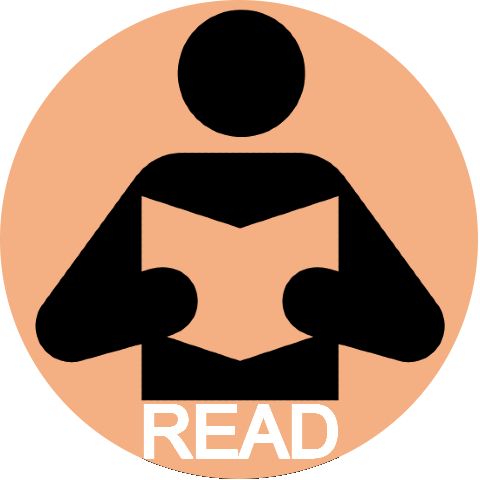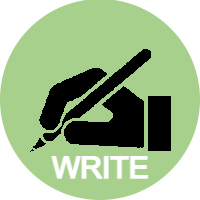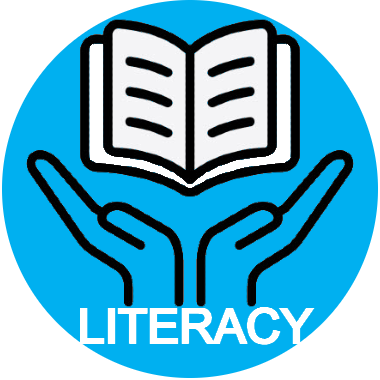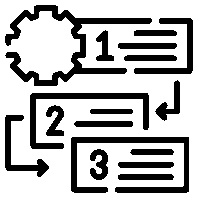ELA-02.R.02

|
2nd Grade (ELA) Targeted Standard
(R) Reading
(C) Comprehension
Learners will read to understand a variety of complex literary and informational texts.
|
ELA-02.R.02 Ask and answer questions about key details before, during, and after reading a variety of literary and informational texts to compare, contrast, predict, or infer.*
 Proficiency Scale Proficiency Scale
Progressions
Standard R.02: Text Comprehension/Inferences
- ELA-00.R.02 Respond to a variety of texts, photographs, or illustrations before, during, and after shared reading or other text-listening experiences to compare, contrast, predict, or infer.
- ELA-01.R.02 Ask and answer questions about a variety of texts, genres, photographs, or illustrations before, during, and after shared reading or other text-listening experiences to compare, contrast, predict, or infer.
- ELA-02.R.02 Ask and answer questions about key details before, during, and after reading a variety of literary and informational texts to compare, contrast, predict, or
infer.*
- ELA-03.R.02 Ask and answer questions about key details before, during, and after reading a variety of genres, literary, and informational texts using text evidence to
compare, contrast, predict, and infer.*
- ELA-04.R.02 Make inferences while reading a variety of genres, literary, and informational texts; providing text evidence.*
- ELA-05.R.02 Make inferences drawn from the text during and after reading a variety of genres, literary, and informational texts.*
- ELA-06.R.02 Comprehend a variety of texts while developing inferences and providing supportive textual evidence.
- ELA-07.R.02 Comprehend a variety of texts while developing inferences and providing supportive textual evidence and reasoning.
- ELA-08.R.02 Comprehend a variety of texts while developing inferences and providing relevant textual evidence and reasoning.
- ELA-09.R.02 Comprehend a variety of texts with multiple levels of complexity while developing inferences and providing relevant textual evidence and reasoning.
- ELA-10.R.02 Comprehend a variety of texts with multiple levels of complexity while developing inferences and providing relevant textual evidence and reasoning.
- ELA-11.R.02 Comprehend a variety of texts with multiple levels of complexity while developing inferences and providing relevant textual evidence and reasoning.
- ELA-12.R.02 Comprehend a variety of texts with multiple levels of complexity while developing inferences and providing relevant textual evidence and reasoning.
|
|
ELA-02.R.03a

|
2nd Grade (ELA) Targeted Standard
(R) Reading
(C) Comprehension
Learners will read to understand a variety of complex literary and informational texts.
|
ELA-02.R.03a Identify the main idea with supporting details during or after reading an informational text or passage.*
 Proficiency Scale Proficiency Scale
Progressions
Standard R.03a: Summarizing Nonfiction Text
- ELA-00.R.03a Tell about the informational text, photographs, or illustrations before, during, or after a shared reading or other text-listening experience.*
- ELA-01.R.03a Identify the topic of an informational text, photograph, or illustration during or after a shared reading or other text-listening experiences.*
- ELA-02.R.03a Identify the main idea with supporting details during or after reading an informational text or passage.*
- ELA-03.R.03a Summarize the main idea(s) with supporting details during or after reading an informational text or passage.*
- ELA-04.R.03a Summarize an informational text or passage, stating the main idea(s) and providing supporting details.*
- ELA-05.R.03a Summarize an informational text or passage, stating the main idea(s) and providing supporting details.*
- ELA-06.R.03a Summarize nonfiction texts objectively, including relevant details.
- ELA-07.R.03a Summarize and/or paraphrase nonfiction texts objectively, including relevant details and avoiding unnecessary information.
- ELA-08.R.03a Summarize and/or paraphrase nonfiction texts objectively, including relevant details and avoiding unnecessary information.
- ELA-09.R.03a Summarize and/or paraphrase nonfiction texts objectively, including relevant information.
- ELA-10.R.03a Summarize and/or paraphrase nonfiction texts objectively, including relevant information.
- ELA-11.R.03a Summarize and/or paraphrase nonfiction texts objectively, including relevant information.
- ELA-12.R.03a Summarize and/or paraphrase nonfiction texts objectively, including relevant information.
|
|
ELA-02.R.03b

|
2nd Grade (ELA) Targeted Standard
(R) Reading
(C) Comprehension
Learners will read to understand a variety of complex literary and informational texts.
|
ELA-02.R.03b Retell the plot to include the beginning, middle, and end of a literary text after reading.*
 Proficiency Scale Proficiency Scale
Progressions
Standard R.03b: Summarize Literary Text
- ELA-00.R.03b Tell about characters and setting in a literary text during or after a shared reading or other text-listening experience.*
- ELA-01.R.03b Identify characters, setting, and plot in a literary text during or after a shared reading or other text-listening experience.*
- ELA-02.R.03b Retell the plot to include the beginning, middle, and end of a literary text after reading.*
- ELA-03.R.03b Summarize the story by including major story elements after reading a literary text or passage.*
- ELA-04.R.03b Summarize the story by including major story elements after reading a literary text or passage.*
- ELA-05.R.03b Summarize a story by including major story elements after reading a literary text.*
- ELA-06.R.03b Summarize literary texts objectively, including relevant details.
- ELA-07.R.03b Summarize and/or paraphrase literary texts objectively, including relevant details and avoiding unnecessary information.
- ELA-08.R.03b Summarize and/or paraphrase literary texts objectively, including relevant details and avoiding unnecessary information.
- ELA-09.R.03b Summarize and/or paraphrase literary texts objectively, including relevant information.
- ELA-10.R.03b Summarize and/or paraphrase literary texts objectively, including relevant information.
- ELA-11.R.03b Summarize and paraphrase literary texts objectively, including relevant information.
- ELA-12.R.03b Summarize and paraphrase literary texts objectively, including relevant information.
|
|
ELA-02.R.05

|
2nd Grade (ELA) Targeted Standard
(R) Reading
(C) Comprehension
Learners will read to understand a variety of complex literary and informational texts.
|
ELA-02.R.05 Determine the meaning of unknown words and phrases through a variety of text experiences.*
 Proficiency Scale Proficiency Scale
Progressions
Standard R.05: Use Text to Determine Word Meaning
- ELA-00.R.05 Determine the meaning of unknown and multiple-meaning words and phrases through read-alouds or other text-listening experiences.*
- ELA-01.R.05 Determine the meaning of unknown and multiple-meaning words and phrases through read-alouds or other text-listening experiences.*
- ELA-02.R.05 Determine the meaning of unknown words and phrases through a variety of text experiences.*
- ELA-03.R.05 Determine the meaning of unknown and multi-meaning words within a text.*
- ELA-04.R.05 Determine the meaning of unknown and multiple-meaning words and phrases within a text.*
- ELA-05.R.05 Determine the meaning of unknown and multiple-meaning words and phrases within a text.*
- ELA-06.R.05 Determine the meaning of words and phrases as they are used in the text, including figurative, denotative, and connotative meanings.
- ELA-07.R.05 Determine the meaning and purpose of words and phrases as they contribute to the text, including figurative, denotative, and connotative meanings.
- ELA-08.R.05 Determine the meaning and purpose of words and phrases as they contribute to the text, including figurative, denotative, and connotative meanings.
- ELA-09.R.05 Determine the meaning and purpose of words and phrases as they are used in the text, including academic vocabulary, figurative, ambiguous, and connotative meanings.
- ELA-10.R.05 Determine the meaning and purpose of words and phrases as they are used in the text, including academic vocabulary, figurative, ambiguous, and connotative meanings.
- ELA-11.R.05 Determine the meaning, purpose, and impact of words and phrases as they are used in the text, including academic vocabulary, figurative, ambiguous, and connotative meanings.
- ELA-12.R.05 Determine the meaning, purpose, and impact of words and phrases as they are used in the text, including academic vocabulary, figurative, ambiguous, and connotative meanings.
|
|
ELA-02.R.06

|
2nd Grade (ELA) Targeted Standard
(R) Reading
(TA) Text Analysis
Learners will analyze, interpret, and evaluate complex literary and informational texts that include a wide variety of genres and formats.
|
ELA-02.R.06 Identify text features (e.g., timeline, maps/legends, graphs/charts, subheadings) and use previously learned text features (e.g., table of contents, headings, captions, diagrams, bold/underlined words) to read and understand a text or passage.*
 Proficiency Scale Proficiency Scale
Progressions
Standard R.06: Text Features and Structure
- ELA-00.R.06 Identify photographs, illustrations, and labels during or after a shared reading or other text-listening experience.
- ELA-01.R.06 Recognize basic text features during or after a shared reading or other text-listening experience.
- ELA-02.R.06 Identify text features and use previously learned text features to read and understand a text or passage.*
- ELA-03.R.06 Use text features and previously learned text features to read and understand a text or passage.*
- ELA-04.R.06 Determine the structure of an informational text: ELA-05.R.06 Describe the structure of informational texts:
- ELA-06.R.06 Describe how a paragraph, chapter, stanza, or section fits into the overall structure of a text and contributes to the development of ideas.
- ELA-07.R.06 Analyze the structure an author uses to organize a text, including how the major sections or stanzas contribute to the whole and the development of ideas, and the overall purpose of the text.
- ELA-08.R.06 Analyze the structure an author uses to organize a text, including how sections, paragraphs, stanzas, and/or particular sentences contribute to the development of ideas and the overall purpose of the text.
- ELA-09.R.06 Analyze how the author's choice in structure, form, and format supports the purpose, contributes to the meaning, or impacts the audience.
- ELA-10.R.06 Analyze how the author's choice in structure, form, and format supports the purpose, contributes to the meaning, or impacts the audience.
- ELA-11.R.06 Analyze and evaluate how the author's choice in structure, form, and format supports the purpose, contributes to the meaning, or impacts the audience.
- ELA-12.R.06 Analyze and evaluate how the author's choice in structure, form, and format supports the purpose, contributes to the meaning, or impacts the audience.
|
|
ELA-02.R.08

|
2nd Grade (ELA) Targeted Standard
(R) Reading
(TA) Text Analysis
Learners will analyze, interpret, and evaluate complex literary and informational texts that include a wide variety of genres and formats.
|
ELA-02.R.08 Use a variety of fiction and poetry texts.
 Proficiency Scale Proficiency Scale
Sub-Standards
- (a.) Describe characters' feelings or traits during or after listening to a story.
- (b.) Compare and contrast two or more versions of the same story (e.g., Cinderella stories) or the same type of poem by different authors or from different cultures after listening to a story or poem.
Progressions
Standard R.08: Analysis and Comparison of Literary Texts
- ELA-00.R.08 Use a variety of fiction texts.
- ELA-01.R.08 Use a variety of fiction texts.
- ELA-02.R.08 Use a variety of fiction and poetry texts.
- ELA-03.R.08 Analyze a variety of fiction and poetry texts.
- ELA-04.R.08 Analyze a variety of fiction and poetry texts.
- ELA-05.R.08 Analyze a variety of fiction and poetry texts.
- ELA-06.R.08 Analyze a variety of fiction texts using textual evidence for support.
- ELA-07.R.08 Analyze a variety of fiction texts using textual evidence for support.
- ELA-08.R.08 Analyze a variety of fiction texts using textual evidence for support.
- ELA-09.R.08 Analyze the development and interaction of literary elements and determine how they impact meaning, using strong textual evidence to support the analysis.
- ELA-10.R.08 Analyze the development and interaction of literary elements and determine how they impact meaning, using strong textual evidence to support the analysis.
- ELA-11.R.08 Analyze the development and interaction of literary elements and determine how they impact meaning, using strong and thorough textual evidence to support the analysis.
- ELA-12.R.08 Analyze the development and interaction of literary elements and determine how they impact meaning, using strong and thorough textual evidence to support the analysis.
|
|
ELA-02.wL.01

|
2nd Grade (ELA) Targeted Standard
(Wr) Writing
(LU) Language Usage
Learners will integrate appropriate language and style to ensure effective readability in writing.
|
ELA-02.wL.01 Compose simple and compound sentences.*
 Proficiency Scale Proficiency Scale
Progressions
Standard wL.01: Language Mechanics (K-5)/Language Mechanics and Grammar (6-12)
- ELA-00.wL.01 Compose a simple sentence.*
- ELA-01.wL.01 Compose simple sentences.*
- ELA-02.wL.01 Compose simple and compound sentences.*
- ELA-03.wL.01 Compose simple and compound declarative, interrogative, imperative, and exclamatory sentences.*
- ELA-04.wL.01 Compose simple and compound declarative, interrogative, imperative, and exclamatory sentences.*
- ELA-05.wL.01 Compose simple, compound, and complex sentences.*
- ELA-06.wL.01 Apply language knowledge for a specific task, purpose, intention, and audience, resolving issues of usage as needed.
- ELA-07.wL.01 Apply language knowledge for a specific task, purpose, intention, and audience, resolving issues of usage as needed.
- ELA-08.wL.01 Apply language knowledge for specific tasks, purposes, intentions, and audience, resolving usage issues as needed.
- ELA-09.wL.01 Apply language knowledge for a specific task, purpose, intention, and audience, resolving issues of usage as needed.
- ELA-10.wL.01 Apply language knowledge for a specific task, purpose, intention, and audience, resolving issues of usage as needed.
- ELA-11.wL.01 Apply language knowledge for a specific task, purpose, and audience, resolving issues of usage as needed.
- ELA-12.wL.01 Apply language knowledge for a specific task, purpose, and audience, resolving issues of usage as needed.
|
|
ELA-02.wL.02

|
2nd Grade (ELA) Targeted Standard
(Wr) Writing
(LU) Language Usage
Learners will integrate appropriate language and style to ensure effective readability in writing.
|
ELA-02.wL.02 Recognize and use parts of speech in sentences:*
 Proficiency Scale Proficiency Scale
Progressions
Standard L.02: Grammar (K-5)
- ELA-00.wL.02 Identify parts of speech in sentences orally, with illustrations, or in writing:*
- ELA-01.wL.02 Recognize and use parts of speech in sentences:*
- ELA-02.wL.02 Recognize and use parts of speech in sentences:*
- ELA-03.wL.02 Recognize and use parts of speech in sentences:*
- ELA-04.wL.02 Recognize and use parts of speech in sentences:*
- ELA-05.wL.02 Recognize and use previous grade levels' parts of speech in simple, compound, and complex sentences.*
|
|
ELA-02.Wr  ELA-02.Wr ELA-02.Wr Strand  | (Wr) Writing
Learners will comprehend, analyze, and evaluate literary and informational texts in various formats, genres, and levels of complexity.
|
Clusters- (TTS) Text Types and Structure
Learners will engage in the writing process and produce a variety of texts determined to address different audiences and purposes.
- (WPC) Writing Process and Craft
Learners will develop, strengthen, and produce writing by planning, drafting, revising, editing, and rewriting.
- (LU) Language Usage
Learners will integrate appropriate language and style to ensure effective readability in writing.
Calculation Method for StrandsStrands are larger groups of related standards. The Strand Grade is a calculation of all the related standards. Click on the standard name below each Strands to access the learning targets and rubrics/ proficiency scales
for individual standards within the domain. |
|
ELA-02.Wr.01

|
2nd Grade (ELA) Targeted Standard
(Wr) Writing
(TTS) Text Types and Structure
Learners will engage in the writing process and produce a variety of texts determined to address different audiences and purposes.
|
ELA-02.Wr.01 Produce writing appropriate to the task, purpose, or audience.*
 Proficiency Scale Proficiency Scale
Progressions
Standard Wr.01: Development and Purpose of Writing
- ELA-00.Wr.01 Produce writing through shared and interactive experiences in which the development and organization are appropriate to the task, purpose, or audience.*
- ELA-01.Wr.01 Produce writing through shared and interactive experiences in which the development and organization are appropriate to the task, purpose, or audience.*
- ELA-02.Wr.01 Produce writing appropriate to the task, purpose, or audience.*
- ELA-03.Wr.01 Produce writing that is organized appropriately to the task, purpose, or audience.*
- ELA-04.Wr.01 Produce clear writing in which the development and organization are appropriate to the task, purpose, or audience.*
- ELA-05.Wr.01 Produce clear writing in which the development and organization are appropriate to the task, purpose, or audience.*
- ELA-06.Wr.01 Produce clear writing organized according to the task, purpose, and audience.
- ELA-07.Wr.01 Produce clear and coherent writing organized according to the task, purpose, and audience.
- ELA-08.Wr.01 Produce clear and coherent writing organized logically according to the task, purpose, and audience.
- ELA-09.Wr.01 Write clearly and coherently with appropriate content, format, and style to accomplish a specific purpose for a target audience.
- ELA-10.Wr.01 Write clearly and coherently with appropriate content, format, and style to accomplish a specific purpose for a target audience.
- ELA-11.Wr.01 Write clearly and coherently with appropriate content, format, and style to accomplish a specific purpose for a target audience.
- ELA-12.Wr.01 Write clearly and coherently with appropriate content, format, and style to accomplish a specific purpose for a target audience.
|
|
ELA-02.Wr.02

|
2nd Grade (ELA) Targeted Standard
(Wr) Writing
(TTS) Text Types and Structure
Learners will engage in the writing process and produce a variety of texts determined to address different audiences and purposes.
|
ELA-02.Wr.02 Write using an organizational structure that introduces a topic, includes supporting sentences, and provides a sense of closure.*
 Proficiency Scale Proficiency Scale
Progressions
Standard Wr.02: Organizational Structure
- ELA-02.Wr.02 Write using an organizational structure that introduces a topic, includes supporting sentences, and provides a sense of closure.*
- ELA-03.Wr.02 Write using an organizational structure incorporating a topic sentence, body, and a concluding statement appropriate to the task.*
- ELA-04.Wr.02 Write using an organizational structure incorporating an introductory paragraph, a body, and a concluding section appropriate to the task.*
- ELA-05.Wr.02 Write using an organizational structure incorporating an introductory paragraph, multiple paragraphs (body), and a concluding section appropriate to the task.*
- ELA-06.Wr.02 Write using a clear organizational structure incorporating an introduction, transitions, body paragraph(s), and a conclusion appropriate to the task.
- ELA-07.Wr.02 Write using a clear organizational structure incorporating an introduction, transitions, body paragraph(s), and a conclusion appropriate to the task.
- ELA-08.Wr.02 Write using a clear organizational structure incorporating an introduction, transitions, body paragraph(s), and a conclusion appropriate to the task.
- ELA-09.Wr.02 Create a logical organizational structure with: relevant introduction, and transitional words or phrases to connect the major sections, paragraphs, and sentences, and an appropriate conclusion.
- ELA-10.Wr.02 Create a logical organizational structure with: relevant introduction, and transitional words or phrases to connect the major sections, paragraphs, and sentences, and an appropriate conclusion.
- ELA-11.Wr.02 Create a logical organizational structure with a relevant introduction, and transitional words or phrases to connect the major sections, paragraphs, plus sentences creating a unified whole, and an appropriate
and thoughtful conclusion.
- ELA-12.Wr.02 Create a logical organizational structure with a relevant introduction, and transitional words or phrases to connect the major sections, paragraphs, plus sentences creating a unified whole, and an appropriate
and thoughtful conclusion.
|
|
ELA-02.Wr.03

|
2nd Grade (ELA) Targeted Standard
(Wr) Writing
(TTS) Text Types and Structure
Learners will engage in the writing process and produce a variety of texts determined to address different audiences and purposes.
|
ELA-02.Wr.03 Write informative pieces that include factual details on the topic.
 Proficiency Scale Proficiency Scale
Progressions
Standard Wr.03: Informative/Explanatory/Technical Writing Technique
- ELA-00.Wr.03 Draw and write informative pieces on a topic.
- ELA-01.Wr.03 Write informative pieces that detail the topic.
- ELA-02.Wr.03 Write informative pieces that include factual details on the topic.
- ELA-03.Wr.03 Write organized informative pieces that include factual details on the topic.
- ELA-04.Wr.03 Write organized informative pieces that include factual details on the topic.
- ELA-05.Wr.03 Write organized, informative pieces that include factual details on the topic.
- ELA-06.Wr.03 Write using informative/explanatory techniques to examine and convey complex ideas, concepts, and information utilizing different mediums when appropriate.
- ELA-07.Wr.03 Write using informative/explanatory techniques to examine and convey complex ideas, concepts, and information utilizing different mediums when appropriate.
- ELA-08.Wr.03 Write using informative/explanatory techniques to examine and convey complex ideas, concepts, and information utilizing different mediums when appropriate.
- ELA-09.Wr.03 Write to inform an audience and to explain complex information by creating a clear thesis and providing supporting claims, details, and evidence from a variety of relevant and reliable sources.
- ELA-10.Wr.03 Write to inform an audience and to explain complex information by creating a clear thesis and providing supporting claims, details, and evidence from a variety of relevant and reliable sources.
- ELA-11.Wr.03 Write to inform an audience and to explain complex information by creating a clear thesis and providing supporting claims, details, and evidence from a variety of relevant and reliable sources within discipline-specific
structures utilizing different mediums to provide clarity and context.
- ELA-12.Wr.03 Write to inform an audience and to explain complex information by creating a clear thesis and providing supporting claims, details, and evidence from a variety of relevant and reliable sources within discipline-specific
structures utilizing different mediums to provide clarity and context.
|
|
ELA-02.Wr.04

|
2nd Grade (ELA) Targeted Standard
(Wr) Writing
(TTS) Text Types and Structure
Learners will engage in the writing process and produce a variety of texts determined to address different audiences and purposes.
|
ELA-02.Wr.04 Write opinion pieces on a topic using reasons to support the opinion.
 Proficiency Scale Proficiency Scale
Progressions
Standard Wr.04: Opinion/Argumentative/Persuasive Techniques
- ELA-00.Wr.04 Draw and write opinion pieces on a topic.
- ELA-01.Wr.04 Write opinion pieces on a topic using a reason to support the opinion.
- ELA-02.Wr.04 Write opinion pieces on a topic using reasons to support the opinion.
- ELA-03.Wr.04 Write organized opinion pieces on a topic using evidence to support the opinion.
- ELA-04.Wr.04 Write organized argumentative pieces on a topic using evidence to support the claim.
- ELA-05.Wr.04 Write organized argumentative pieces on a topic using evidence to support the claim.
- ELA-06.Wr.04 Write using argumentative techniques to develop claims using supporting evidence and logical reasoning.
- ELA-07.Wr.04 Write using argumentative techniques to develop claims using supportive evidence and logical reasoning, acknowledging counterclaims when applicable.
- ELA-08.Wr.04 Write using argumentative techniques to develop claims and counterclaims using supporting evidence and logical reasoning.
- ELA-09.Wr.04 Write to persuade an audience
- ELA-10.Wr.04 Write to persuade an audience
- ELA-11.Wr.04 Write to persuade an audience
- ELA-12.Wr.04 Write to persuade an audience
|
|
ELA-02.Wr.05

|
2nd Grade (ELA) Targeted Standard
(Wr) Writing
(TTS) Text Types and Structure
Learners will engage in the writing process and produce a variety of texts determined to address different audiences and purposes.
|
ELA-02.Wr.05 Write narrative pieces that describe a well-elaborated event in sequence.
 Proficiency Scale Proficiency Scale
Progressions
Standard Wr.05: Narrative/Creative Writing Techniques
- ELA-00.Wr.05 Draw and write narrative pieces that describe a single event.
- ELA-01.Wr.05 Write narrative pieces that describe a single event with a beginning, middle, and end.
- ELA-02.Wr.05 Write narrative pieces that describe a well-elaborated event in sequence.
- ELA-03.Wr.05 Write narrative pieces that describe a well-elaborated real or imagined event in a sequence that unfolds naturally.
- ELA-04.Wr.05 Use narrative techniques (e.g., dialogue, description) to write pieces that describe a well-elaborated real or imagined event in a sequence that unfolds naturally.
- ELA-05.Wr.05 Use narrative techniques (e.g., dialogue, description, pacing) to write pieces that describe a well-elaborated real or imagined event in a sequence that unfolds naturally.
- ELA-06.Wr.05 Write using narrative techniques to develop real or imagined experiences or events using well-chosen details and structured event sequences.
- ELA-07.Wr.05 Write using narrative techniques to develop real or imagined experiences or events using well-chosen details and structured event sequences.
- ELA-08.Wr.05 Write using narrative techniques to develop real or imagined experiences or events using well-chosen details and structured event sequences.
- ELA-09.Wr.05 Write to convey real experiences, imaginary events, and poetic expressions by using creative writing techniques, such as narrative, dialogue, sensory details, figurative language, and symbolism, to engage
an audience.
- ELA-10.Wr.05 Write to convey real experiences, imaginary events, and poetic expressions by using creative writing techniques, such as narrative, dialogue, sensory details, figurative language, and symbolism, to engage
an audience.
- ELA-11.Wr.05 Write to convey real experiences, imaginary events, and poetic expressions by using creative writing techniques, such as narrative, dialogue, sensory details, figurative language, and symbolism, to engage
an audience.
- ELA-12.Wr.05 Write to convey real experiences, imaginary events, and poetic expressions by using creative writing techniques, such as narrative, dialogue, sensory details, figurative language, and symbolism, to engage
an audience.
|
|
ELA-02.Wr.06

|
2nd Grade (ELA) Targeted Standard
(Wr) Writing
(WPC) Writing Process and Craft
Learners will develop, strengthen, and produce writing by planning, revising, editing, and rewriting.
|
ELA-02.Wr.06 Develop and strengthen writing utilizing the five steps appropriate to the task.
 Proficiency Scale Proficiency Scale
Progressions
Standard Wr.06: Writing Process
- ELA-00.Wr.06 Develop and strengthen writing utilizing the five steps appropriate to the task:
- ELA-01.Wr.06 Develop and strengthen writing utilizing the five steps appropriate to the task.
- ELA-02.Wr.06 Develop and strengthen writing utilizing the five steps appropriate to the task.
- ELA-03.Wr.06 Develop and strengthen writing utilizing the five steps appropriate to the task and purpose.
- ELA-04.Wr.06 Develop and strengthen writing utilizing the five steps appropriate to the task.
- ELA-05.Wr.06 Develop and strengthen writing utilizing the five steps appropriate to task, purpose, and audience.
- ELA-06.Wr.06 Develop and strengthen writing by planning, drafting, revising, and editing to provide clarity to the audience.
- ELA-07.Wr.06 Develop and strengthen writing by planning, drafting, revising, and editing to address specific purposes for the genre and audience.
- ELA-08.Wr.06 Develop and strengthen writing by planning, drafting, revising, and editing to address specific purposes for the genre and audience.
- ELA-09.Wr.06 Develop and strengthen writing through the writing process to produce a quality product for a specific purpose and audience.
- ELA-10.Wr.06 Develop and strengthen writing through the writing process to produce a quality product for a specific purpose and audience.
- ELA-11.Wr.06 Develop and strengthen writing through the writing process to produce a quality product for a specific purpose and audience.
- ELA-12.Wr.06 Develop and strengthen writing through the writing process to produce a quality product for a specific purpose and audience.
|
|
ELA-02.Wr.07

|
2nd Grade (ELA) Targeted Standard
(Wr) Writing
(WPC) Writing Process and Craft
Learners will develop, strengthen, and produce writing by planning, revising, editing, and rewriting.
|
ELA-02.Wr.07 Write with intentional word choice that integrates emotion or descriptive language.
 Proficiency Scale Proficiency Scale
Progressions
Standard Wr.07: Word Choice/Voice
- ELA-00.Wr.07 Produce shared and interactive writing with emotion or personality expressed through word choice.
- ELA-01.Wr.07 Produce writing with emotion or personality expressed through word choice.
- ELA-02.Wr.07 Write with intentional word choice that integrates emotion or descriptive language.
- ELA-03.Wr.07 Write with intentional word choice that integrates emotion and descriptive language to develop visual imagery for the reader.
- ELA-04.Wr.07 Write with intentional word choice that integrates emotion or figurative language to develop visual imagery for the reader.
- ELA-05.Wr.07 Write with intentional word choice that integrates emotion or figurative language to create a mood for the reader.
- ELA-06.Wr.07 Produce writing that uses intentional word choice and voice to match the writing purpose.
- ELA-07.Wr.07 Produce writing that uses intentional word choice and voice to match the writing purpose.
- ELA-08.Wr.07 Produce writing that uses intentional word choice and voice to match the writing purpose.
- ELA-09.Wr.07 Integrate vocabulary and figurative language to create a particular style and/or voice which supports the purpose of writing.
- ELA-10.Wr.07 Integrate vocabulary and figurative language to create a particular style and/or voice which supports the purpose of writing.
- ELA-11.Wr.07 Integrate vocabulary and figurative language to create a particular style and/or voice which supports the purpose of writing.
- ELA-12.Wr.07 Integrate vocabulary and figurative language to create a particular style and/or voice which supports the purpose of writing.
|
|


 (F)
(F)
 (C)
(C)
 (R)
(R)
 (Wr)
(Wr)
 (IR)
(IR)


